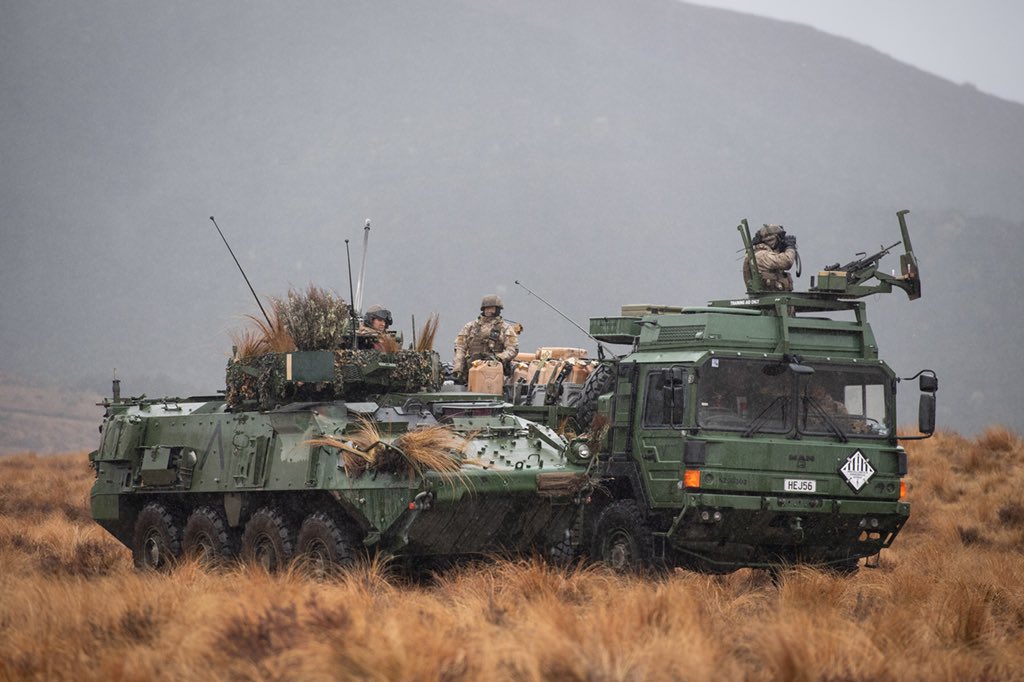Since the Ardern government took office, we've been treated to a veritable deluge of publically launched defence policy documents. Minister Ron Mark has had no need of a new White Paper – the next one is due no earlier than 2021. But last year he launched something arguably just as significant in a Strategic Policy Statement which changed New Zealand's tune on China and paved the way for the purchase of the P8 maritime surveillance and patrol aircraft.
 Artist impression of a Boeing P-8A Poseidon in RNZAF colours
Artist impression of a Boeing P-8A Poseidon in RNZAF coloursThe government’s ambitious remit for the defence force has since been spelled out in a new Defence Capability Plan. There are now so many major projects (many exceeding $1billion) that one has to wonder about the breaking point for the purse-strings of future governments. And that’s not all for readers of defence policy pronouncements. Last year saw the first edition of a new series of Assessments explain how defence was taking climate change seriously, including in the Pacific. Jointly released by James Shaw, this was one way for Mr Mark to thank the Greens for their agreement to some of the above, including expensive aircraft good at finding submarines.
The second assessment has now been launched, this time dealing New Zealand's defence priorities in the South Pacific. Its ostensible purpose takes us back to one of the most important lines in last year’s big Statement: that the South Pacific would now be treated with the same operational importance as the defence of New Zealand and its immediate surrounds. As well as connecting to the government’s Pacific Reset, there is also a flow on from the climate change assessment. This week’s new paper highlights the Boe Declaration in which Pacific Island Forum (PIF) countries identified climate change as the region’s most serious and urgent problem.
- Capable for what? New Zealand’s 2019 defence capability plan
- Defence Minister Commits To Rebuilding Reserve Force
- Defence Capability 2019 – reading between the lines
- Defence Minister Ron Mark hopes China 'adheres to openness and transparency like we do'
But the writers of the new Pacific assessment seem to be even more worried about growing “strategic competition” in the South Pacific. These two words can readily be translated to mean China’s growing influence. China is only mentioned once in the document - in a list of the PIF’s dialogue partners. But Beijing’s presence hovers in the background when we read that: “the pace, intensity, and scope of engagement by external actors, who may not always respect our values across their activities, are at the heart of a growing sense of geostrategic competition that is animating many nations’ renewed focus on the Pacific.” And who else but China can fit the following bill? “Geostrategic competition is not simply a consequential trend playing out among great powers. If external powers establish a greater regular presence, it could materially affect the Pacific and our own strategic circumstances.”
 C-130H Hercules to be replaced by the C-130J-30 Super Hercules
C-130H Hercules to be replaced by the C-130J-30 Super HerculesNew Zealand’s main response to this challenge is working with “like-minded partners” who “share our concern about intensifying complex disruptors and competition.” It’s obvious that the writers have some of New Zealand’s bigger western partners in mind. These include Australia, France and the United States who with New Zealand constitute the Quads grouping which garners special attention. The fine print of the Assessment also records that Washington’s Compact arrangements in Micronesia “give the United States the authority to potentially deny access by other countries’ militaries and their personnel.” Is there a faint whiff here of strategic denial, an approach last entertained in the region when there were worries about Soviet influence at the end of the Cold War?
It’s the language that gives the geopolitical game away. In their foreword, Chief of Defence Force Kevin Short and newly appointed Defence Secretary Andrew Bridgman explain that “Together with other government agencies, our Pacific partners, and likeminded partners, New Zealand Defence aims to contribute to the maintenance of our collective values and interests, including open access, freedom of movement, and transparency.” This reads as if the South Pacific is connected by a hitherto undiscovered umbilical cord to the South China Sea. That New Zealand’s defence officials are increasingly inclined to connect the South Pacific to a wider contest is clear in what comes next next: “A range of partners maintain special relationships and constitutional obligations in the Pacific, and undertake efforts to support democratic values and the rules-based order throughout the broader Indo-Pacific region.”
 A New Zealand LAVIII and MHOV on exercise
A New Zealand LAVIII and MHOV on exerciseThe potential for contradictions rather than consistency is stark. New Zealand should rightly be concerned about the destabilising effects of geostrategic competition in the South Pacific. But if that is the case, why is Wellington seeking the help of traditional partners to intensify the rivarly? And if some of New Zealand’s Southeast Asian partners have been concerned that Indo-Pacific conceptions may marginalize their own architectural efforts, why would New Zealand want to drag this logic into the South Pacific where the power asymmetries are even grander? Is this really the time to be emphasizing connections with traditional partners attached to Indo-Pacific enthusiasms and warnings whose leaders are playing dumb and dumber on climate change?
Now to be fair to the Assessment, much is made of the importance of partnering with the Pacific countries themselves. This priority is depicted by proverb, image, diagram and ocean-going metaphor (canoe). But notwithstanding these efforts to promote New Zealand as a Pacific partner of choice which supports a resolute approach to climate change, the new assessment gives too much away to great power balancing. That’s a world where small states and their concerns aren’t important in and of themselves. As this would be inconsistent with New Zealand’s interests and values, a rethink of this aspect of the Reset is in order.






